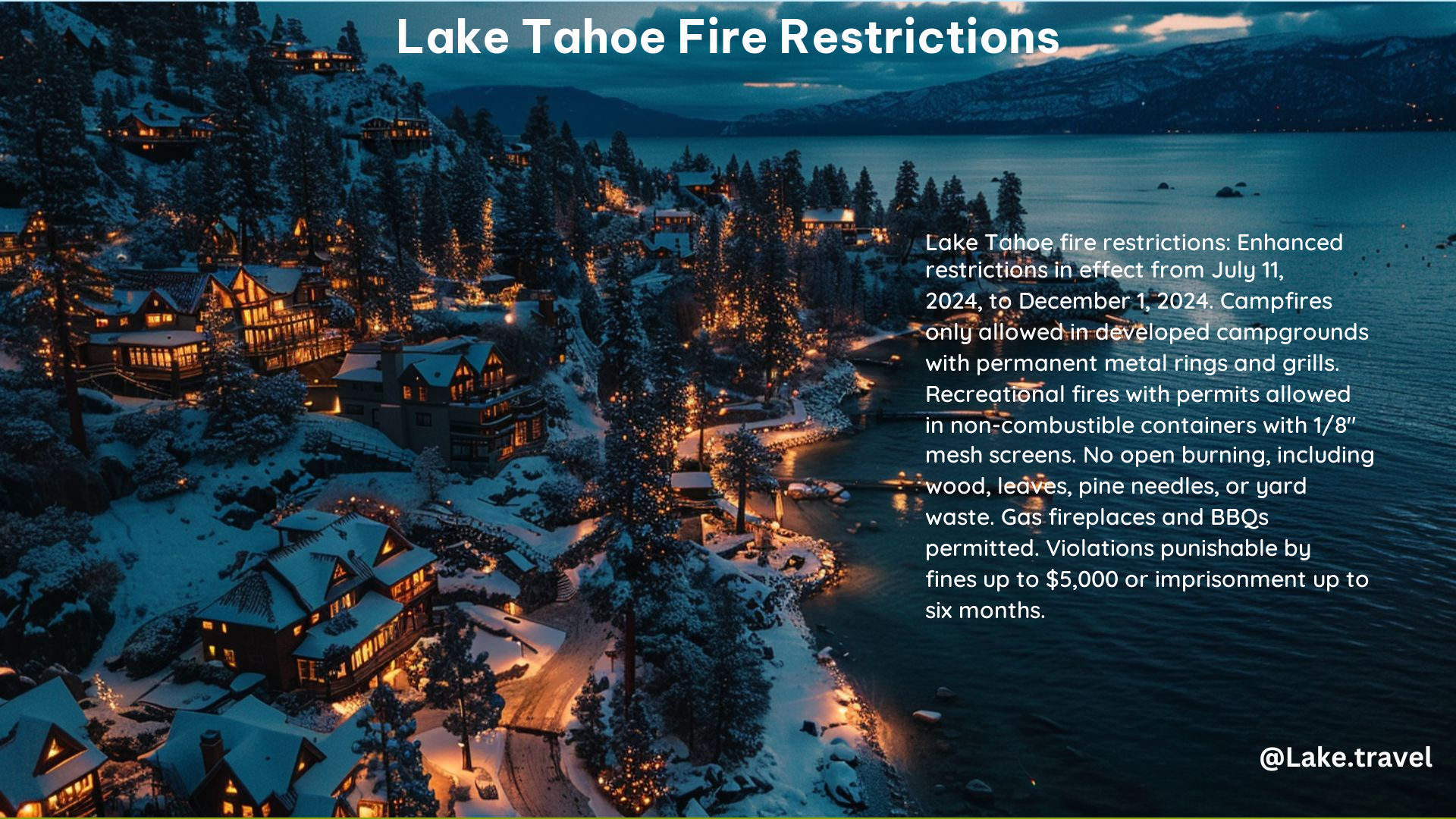Overview
The Lake Tahoe Basin Management Unit (LTBMU) and surrounding areas have implemented various fire restrictions to ensure public safety and protect the environment. These restrictions apply to different types of fires, including campfires, recreational fires, and open burning.
Campfires

- National Forest Lands: Campfires are only permitted within permanent metal rings and grills in developed campgrounds, picnic areas, yellow post sites, and designated campsites.
- Enhanced Restrictions: From July 11, 2024, to December 1, 2024, campfires are restricted to developed campgrounds with permanently installed campfire pits and barbecue grills. Devices with shut-off switches or valves, such as portable campfire pits, lanterns, or stoves using gas, kerosene, or pressurized liquid fuel, are allowed in developed recreation sites.
Recreational Fires
- Permitted Areas: Recreational fires (wood or charcoal fires within a non-combustible container with a 1/8″ mesh screen) are allowed with a permit in specific areas, excluding short-term rental properties.
- Requirements: These fires must be at least 30 feet away from combustibles, structures, and vegetation, and a charged water hose or a 4A extinguisher must be within reach.
Open Burning
- Prohibited: Open burning of wood, leaves, pine needles, yard waste, or brush is not allowed within the City of South Lake Tahoe limits or in most areas of the Lake Tahoe Basin.
Gas Fire Pits and BBQs
- Allowed: Gas fire pits and BBQs using natural gas or propane are permitted with a permit, following manufacturer specifications.
Additional Restrictions
- Smoking: Smoking is restricted to enclosed vehicles or areas at least three feet in diameter that are barren or cleared of all flammable materials.
- Off-Highway Vehicles: Operating internal combustion engines off paved, gravel, or dirt National Forest roads and trails is restricted, except in designated areas.
- Welding: Welding or operating an acetylene or other torch with an open flame is restricted.
Penalties
Violations of these prohibitions can result in fines of up to $5,000 for individuals or $10,000 for organizations, or imprisonment for not more than six months, or both.
Contact Information
- Forest Supervisor’s Office: Open Monday through Friday, 8-4:30 p.m. (excluding federal holidays). Phone: 530-543-2600. Email: [available on the website].
- North Lake Tahoe Fire Protection District: Contact Tia Rancourt, Public Education/Information Officer, at [available on the website].
- City of South Lake Tahoe Fire Inspector: Dan Brown, 530-542-6019, [email protected].
Additional Facts and Data Points
- The Lake Tahoe Basin is a popular destination for outdoor enthusiasts, attracting millions of visitors each year. The region’s natural beauty and diverse ecosystems make it a prime target for wildfires, which can have devastating consequences.
- The enhanced fire restrictions implemented in 2024 are a response to the increasing risk of wildfires in the area. The restrictions aim to limit the potential ignition sources and reduce the likelihood of a catastrophic fire event.
- According to the USDA Forest Service, the Lake Tahoe Basin has experienced several large-scale wildfires in recent years, including the Caldor Fire in 2021, which burned over 200,000 acres and threatened the communities around the lake.
- The North Lake Tahoe Fire Protection District reports that the majority of wildfire ignitions in the region are caused by human activities, such as campfires, recreational fires, and open burning. The fire restrictions are designed to mitigate these risks and protect the local environment.
- The City of South Lake Tahoe has also implemented its own fire prevention measures, including a ban on open burning and strict regulations on the use of gas fire pits and BBQs. These local-level efforts complement the regional fire restrictions enforced by the LTBMU.
- Visitors to the Lake Tahoe Basin are encouraged to familiarize themselves with the current fire restrictions and to follow all safety guidelines when engaging in outdoor activities. Failure to comply with these regulations can result in significant fines and legal consequences.
References
- USDA Forest Service. (n.d.). Campfire Restrictions at Lake Tahoe. Retrieved from https://www.fs.usda.gov/detail/ltbmu/home/
- North Lake Tahoe Fire Protection District. (n.d.). Outdoor Burning. Retrieved from https://nltfpd.org/outdoor-burning
- USDA Forest Service. (n.d.). Fire restrictions and guidelines for the Tahoe National Forest. Retrieved from https://www.fs.usda.gov/detail/tahoe/notices/
- City of South Lake Tahoe. (n.d.). Fire Prevention. Retrieved from https://www.cityofslt.us/176/Fire-Prevention
- Tahoe Daily Tribune. (2024, July 12). Forest Service announces enhanced fire restrictions at Lake Tahoe. Retrieved from https://www.tahoedailytribune.com/news/forest-service-announces-enhanced-fire-restrictions-at-lake-tahoe/.
